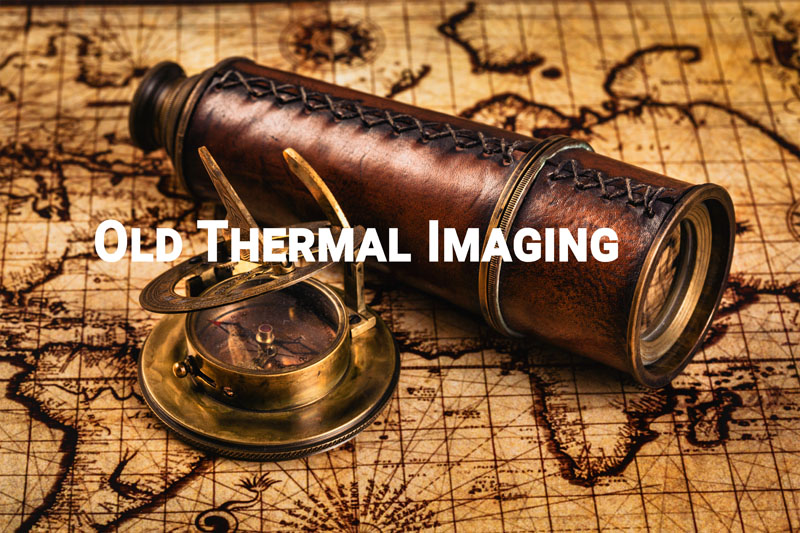It’s not easy at all to hunt at night or in tough surroundings where not all animals are visible at once. This is why people are constantly looking for thermal imaging for hunting. That way whenever an animal crosses their view they can easily spot it and act accordingly. Unlike the regular optics which showcase the views in colors or black and white at night, these ones are able to read the body temperature and point the location of a living creature right away. In many instances, they can do this regardless of the obstacles that may appear between the hunter and the target.
The fact that this hobby is legal in many states makes the need for proper thermal imaging even greater. Luckily, there are plenty of models of monoculars, rifle scopes, cameras, and other imagers available on the market. All you should do is to come across the right ones for you. To give you a hand with this matter, in the following paragraphs, we’ll present some of the top models together with a guide for buyers.
Top 3 Picks: Best Thermal Imaging for Hunting
BEST VALUE
Pulsar Thermion XM50 Thermal Riflescope

BEST OVERALL
IR Defense IR Hunter Mark II 640 Thermal Rifle Scope
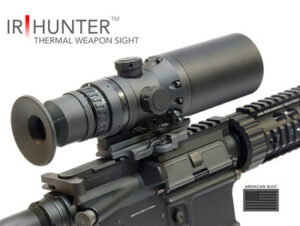
BEST PRICE
Pulsar Helion Thermal Monocular
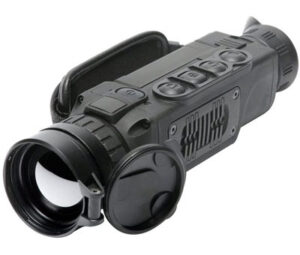
10 Thermal Imaging To Choose From
Thermal imaging has come a long way. While in the past, these imagers were way more expensive and less accessible than today, nowadays users can find them faster and at not-so-high prices. And many of them can be utilized for more activities than just hunting, which users find useful. Another thing worth mentioning is the fact that these imagers can usually record videos and take photos of the thermal views for further viewing and sharing. Because of all of this, it’s important to look at what is offered on the market with care and make decisions on the overall features.
So, if you are curious to know more about this, here we present some full reviews of the best models on the market.
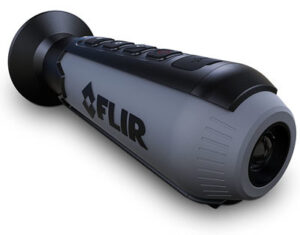
FLIR Ocean Scout TK Monocular, Dark Gray
When people are hunting in low light or in the dark, they need an easily reachable thermal imager that is comfortable to use. This one matches this description. Firstly, it can fit in any pocket. Not to mention that it can recognize the temperature of living creatures from afar.
Easy to operate and with digital capabilities, this monocular can record videos and take photos during your trips, as well. This is applicable both for on and off the water. Moreover, thanks to the option to pick color palettes, users can control how they record their videos.
But it has to be noted that as a possible downside users report the troubles with the zoom at long distances.
Read More: Best Thermal Imaging Monoculars.

Pulsar Helion Thermal Monocular
Pulsar made this monocular with a wide variety of applications. Specifically for hunters, it provides a nice digital zoom and detection range. To increase precision while locating the animals, there is a reticle for stadiametric rangefinding. Understandably, the weather conditions are changing all the time in the open, which is why this model is waterproof, fog proof, and dustproof.
Those that prefer to view in more colors can take advantage of the 8 palettes with colors, as well. Not to forget, it can be connected to a smartphone through an app and all the recorded contents can be transferred between the devices.
Despite all of this, though, a downside to have in mind is the weight being a bit high when compared to some other models.
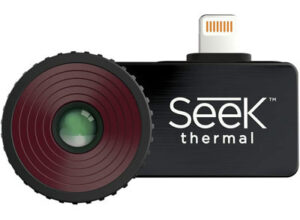
Seek Thermal Compact-All-Purpose Thermal Imaging Camera
As its name says, this thermal camera can be utilized for a range of activities, including hunting. Since it can be connected to a smartphone, hunters can take it everywhere with them to be able to detect the animals with efficiency and speed.
Among its notable features are the thermal sensor with nice quality, the waterproof case, and the long detection range. Thanks to these, people can hunt in different places. What users find handy is the fact that it can operate when the temperature is low. There are also 9 color palettes that users can choose from.
Yet apparently they experience certain difficulties with the software updates bugs that may appear sometimes as well as the fact that the zoom is greater than through the phone.

Pulsar Thermion XM50 Thermal Riflescope
Pulsar is a reputable brand when it comes to thermal imaging. It proves this with this thermal scope, as well. For starters, the rifle scope has a strong digital zoom and a colorful screen that provides clear images in nearly all conditions. Aside from the options to capture videos and photos, it’s mobile-friendly and the files can be easily transferred to your smartphone.
Another helpful detail is the very large detection range accompanied by the high-rated recoil. This is very useful in terms of hunting. Not to mention that it can withstand the weather because it’s IPX-7-rated for water resistance. In fact, it can stay for a maximum of 30 minutes in 3 feet water.
However, you should be aware that people complain about the eye relief being too close for some of them and the lack of long battery life.
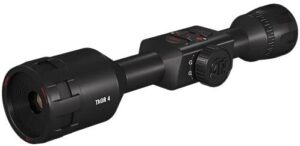
ATN ThOR 4, 384×288, Thermal Rifle Scope
As a premium model, this thermal rifle scope incorporates the modern generation of sensors that are known to have a dual core. They contribute to the improved thermal sensitivity and make the resolution and sharpness better.
Also, the scope has some digital features like the ability to capture photos and videos, stream them via Wi-Fi as well as a calculator for setting the ballistics even at a long distance.
Still, users report that they had some trouble spotting certain animals in the dark.
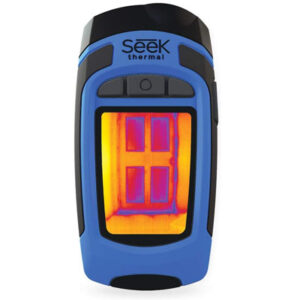
Seek Thermal Reveal – Ruggedized, All-Purpose Thermal Imaging Camera
Hunters will find pleasure in this thermal imaging device predominantly because it acts both as a camera and as a LED light. This helps them see their target clearly no matter the light.
As a durable device, it can be utilized for a longer time. And it’s handheld, making it even easier to handle in nature. Not to mention that it can be controlled with a press of a button, identifying sources of heat at a great distance.
However, it’s worth mentioning that with this imager, you can’t see the temperature through objects and there is no video playback option.

FLIR ONE Pro – iOS – Professional Grade Thermal Camera
This thermal imager is utilized as an addition to people’s smartphones. Mainly, it comes in handy for discovering hidden problems and targets. For increased sharpness of the views and efficient performance, it comes with image-enhancement options.
Moreover, people can record videos with it and transfer them on the phone. Yet its battery life tends to be a bit short, which can cause people some uncertainties.
Still, in general, it’s a model that’s worth checking out by both hobbyists and professionals.

IR Defense IR Hunter Mark II 640 60hz 35mm Thermal Rifle Scope
With an elegant and sleek design and a black exterior, this thermal scope performs well in different types of situations, as well as surroundings. The visuals it provides are in black and white. And users can see plenty of details when they’re observing their subjects. A reason for that is the great resolution.
Subsequently, the model is waterproof and resistant to fog. This makes it even more long-lasting and adequate for usage in various weather conditions.
Further, battery life averages around five hours, which is suitable for regular viewing, but it can be extended. Even though the resolution is great, the magnification power is still a bit low when compared to similar models.

PerfectPrime IR0002, Infrared (IR) Thermal Imager & Visible Light Camera
This thermal imager delivers satisfactory results when it comes to searching and rescuing, home usage, as well as industrial usage. A number of features can be easily modified to suit the preferences of the user. The imager can take pictures, too. This visual material can be stored on a micro SD card. What’s more, its capacity is four gigabytes.
It’s worth noting that some customers thought that the resolution is a bit low and the refresh rate is also slightly lower. However, that’s to be expected as this is a pretty affordable model.
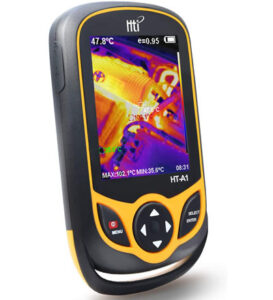
Hti-Xintai 220 x 160 Thermal Imaging Camera
Beginning with the images it delivers, the model has full multi-coatings for clear and crisp visuals. It has flip-up lens covers for additional protection, too.
But the real capabilities of the binoculars come into the light during the night. They perform well in complete darkness. And the IR illuminator, which the manufacturer made it very energy-efficient and integrated it in the model, is here to help in these situations.
Users can operate with it for quite some time without stopping because the design has no-slip features and is pretty strong and ergonomic.
On the other hand, a few buyers noted that it doesn’t behave well in closed areas like a forest and stated that some had trouble with the focus.
Identifying 6 rights before you have it
Resolution of Images
Naturally, the image resolution is different when it comes to basic models and high-end ones. Further, the former cost less and have a smaller resolution. On the other hand, the latter option has a higher price yet the resolution is also bigger.
Both thermal imaging pieces of equipment can be used for the same thing. However, there are some important differences. The pricier models are way better at detecting animals when they’re far away from where you’re standing. Also, they’re better at separating objects from actual animals.
Magnification
Thermal imaging optics are known for possessing a digital zoom. Still, the magnification capabilities may cause some disruptions and can sometimes even confuse users about which model is best.
It’s recommended to look for imagers that have a bigger objective lens and native magnification powers. That’s usually the case because this type of magnification provides more clarity. And the visuals appear less grainy. As you surely know, when you use the magnification too much, the image you’re seeing is pixelated, which means that small squares appear. This can negatively influence the quality of the image. This situation is especially noticeable when it comes to basic models.
That’s why many people suggest going for a higher resolution and lower magnification.
Black and White vs. Full Color
If the user sees colors or just black and white images while looking through the thermal imagers is also another factor to consider. While it may not be at the top of the list of priorities, it’s still worth deciding which one suits you better.
It’s widely regarded that users see more easily with black-and-white imagers. These tend to be less expensive, too. These models usually are known for higher resolutions. However, they’re unable to perceive ranges of the temperature of the subject that the user is observing.
On the other hand, the full-color ones can do that. But, a higher price may be written on their price tag. Still, it’s up to the personal preferences of each buyer.
Refresh Rate
For those who aren’t entirely familiar with the term, it signifies how frequently the image refreshes. A higher rate means that users get a more precise image and the whole experience is smoother. In turn, this capability can increase the price of the model.
Some agree that a refresh rate of around thirty hertz or something north of that. This allows users to easily follow a subject and get flowing visuals.
Battery Life
The battery life of the thermal imager is largely determined by how much it’s used. This is an important feature because it can seriously limit the user and the way they utilize the model. This is especially the case if you find yourself on a wide field or on a mountain without a power source. So, it goes without saying that buyers typically look for longer battery life so they can operate with the imager for a long time without having to recharge the battery every so often.
What’s more, it’s considered that the battery lasts for about eight hours on average. Usually, this is characteristic of the more expensive models. Generally speaking, battery life from eight to twelve hours is pretty much standard.
However, this doesn’t have to be a make-it-or-break-it moment. Some models have battery trays for extra batteries. Also, external batteries are becoming a common thing in the field. These batteries can significantly increase the period of usage.
The Product’s Warranty and Customer Service
Sometimes when two imagers are very much alike, details, which may appear small at the beginning, can make all the difference. What we’re talking about is the warranty period. Brands have different warranty periods among themselves, so it’s in your interest to look for models with a longer period. This means that if something happens to the product, you know that you can rely on the company to fix the issue even several years after the original purchase.
Closely connected to the company’s warranty policy is the customer service. At first glance, you may not see the correlation between a thermal imager and the customer service of the company that made it and sells it. However, something will happen to the product eventually. And you will definitely like the company to take care of the issue and treat you respectfully, instead of it being dismissive about it.
Frequently Asked Questions (FAQs)
1) How does thermal imaging work?
Answer: In order to come up with images of subjects, thermal imaging, as a method, uses thermal energy, as well as infrared. Using these two, imagers that use this method get all the information that’s needed to form an image, which a user finally receives. This can happen even during low-light conditions and in surroundings with a lower source of light. It’s still considered to be a contemporary and newer technology. However, it’s risen to prominence quickly over the past period and is used for numerous activities among which is, of course, hunting.
2) How much does thermal imaging cost on average?
Answer: This is a pretty subjective question that depends on the particular model, its features and specifications, the manufacturer, and more. Still, it’s claimed that imagers can cost from a hundred dollars to three thousand dollars and more. Naturally, the pricier models offer premium features for an enhanced observational experience. Yet, users can find decent models with great performance at more affordable prices. So, attaching yourself to the most expensive model you can possibly find doesn’t sound like a great idea if you previously haven’t assessed all the available options for getting a reliable thermal imager.
3) Can I see through walls with a thermal imager?
Answer: Not exactly. Thermal cameras, for one, can detect the temperature that’s emitted from a subject. So, even though you can precisely see through walls, you can still pretty much find out some sensitive information that can be useful to you regarding what’s happening beyond the wall.
Final words
Having all of these things in mind, it can be said with certainty that thermal imaging is helpful while hunting. Rather than providing the traditional views that lack more thorough details, they enable shooters to see where their targets are based on body temperature. Of course, there are many details that make this possible, starting from the magnification and screens up to the options to capture photos and videos and store them.
Moreover, these are largely dependent on the type of thermal imaging device and its capabilities. For this reason, before making the purchase, you should stop for a bit and think about what you want from your imager in the first place. We hope we assisted you with this.
Finally, it’s time to hear from you. Where do you stand on this matter? Which thermal imager are you getting? Share your hunting experiences with these devices and your opinions in the comments.

